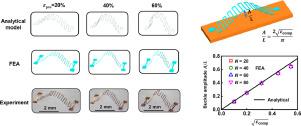Journal of the Mechanics and Physics of Solids ( IF 5.0 ) Pub Date : 2021-07-15 , DOI: 10.1016/j.jmps.2021.104568 Jianzhong Zhao 1, 2 , Fan Zhang 3 , Xingming Guo 1 , Yonggang Huang 2, 4, 5 , Yihui Zhang 3 , Heling Wang 6

|
Buckling of a single ribbon is the simplest type of instability in mechanics. Recently postbuckling has been adopted in three-dimensional (3D) assembly technique to form diverse 3D architectures from planar precursors. amongst various structures, 3D serpentine structures are remarkable, especially in stretchable electronics and micro-electro-mechanical systems, as they provide ultra-low rigidity and high stretchability. Previous studies on those structures are mainly based on finite element analysis and individually focused on features such as the resonant frequency, critical compression for buckling and stretchability. A comprehensive theoretical model that fully reveals the mechanical behaviour of such structures and provides detailed information such as the displacement/rotation, curvature and strain distribution, is essential for applications that require a tailored structural design. Here an analytical model in very concise and explicit form is developed, showing that the postbuckling of serpentine structures obeys similar rules as that of a straight ribbon, with the effective torsional rigidity playing the role of the bending rigidity. The effective torsional rigidity involves not only the cross-sectional profile (ribbon width and thickness) but also the geometry parameters unique in the serpentine structures, which significantly enlarges the design space. Using serpentine structures of unidentical ribbons, an inverse design strategy is proposed to form various architectures buckled from planar precursors, without adopting spatial-varying cross-sectional thicknesses or widths as in previous works. A multi-directional strain sensor with ultra-low rigidity is also presented to demonstrate the application of the theoretical model. The above results also indicate that complexity (rich design space) and conciseness (simple rules) could coexist in 3D serpentine structures, which is rare in other structures formed by the mechanics-guided 3D assembly.
中文翻译:

扭转变形主导蛇形结构屈曲形成超低刚度三维结构
单条带的屈曲是力学中最简单的不稳定性类型。最近,后屈曲已被用于三维 (3D) 组装技术,以从平面前体形成不同的 3D 结构。在各种结构中,3D 蛇形结构非常出色,尤其是在可拉伸电子和微机电系统中,因为它们具有超低刚度和高拉伸性。以前对这些结构的研究主要基于有限元分析,并单独关注共振频率、屈曲临界压缩和拉伸性等特征。一个全面的理论模型,可以充分揭示此类结构的力学行为,并提供位移/旋转、曲率和应变分布等详细信息,对于需要量身定制的结构设计的应用来说是必不可少的。这里建立了一个非常简洁和明确形式的分析模型,表明蛇形结构的后屈曲遵循与直带相似的规则,有效扭转刚度起到弯曲刚度的作用。有效扭转刚度不仅涉及横截面轮廓(带宽度和厚度),还涉及蛇形结构中独特的几何参数,这显着扩大了设计空间。使用不同带的蛇形结构,提出了一种逆向设计策略,以形成从平面前体弯曲的各种结构,而不像以前的工作那样采用空间变化的横截面厚度或宽度。还提出了一种具有超低刚度的多向应变传感器来演示理论模型的应用。上述结果还表明,复杂性(丰富的设计空间)和简洁性(简单的规则)可以在 3D 蛇形结构中并存,这在由机械引导的 3D 装配形成的其他结构中是罕见的。











































 京公网安备 11010802027423号
京公网安备 11010802027423号